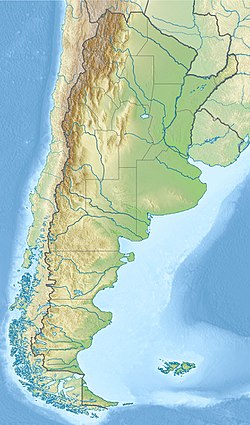| La Colonia Formation | |
|---|---|
| Stratigraphic range: Campanian-Maastrichtian ~ | |
 An outcrop of the La Colonia Formation on the Somún Curá plateau that is the type locality of Chubutinectes. Photographed in 2009. | |
| Type | Geological formation |
| Sub-units | Lower, Middle and Upper members |
| Underlies | El Buitre & Sarmiento Formations |
| Overlies | Cerro Barcino & Paso del Sapo Formations |
| Thickness | Up to 210–240 m (690–790 ft) Thinning to 17 m (56 ft) around Telsen |
| Lithology | |
| Primary | Siltstone |
| Other | Sandstone, claystone, conglomerate |
| Location | |
| Coordinates | 43°00′S 67°30′W / 43.0°S 67.5°W |
| Approximate paleocoordinates | 45°42′S 53°48′W / 45.7°S 53.8°W |
| Region | Chubut Province |
| Country | Argentina |
| Extent | Cañadón Asfalto Basin |
| Type section | |
| Named for | Sierra La Colonia |
The La Colonia Formation is a geological formation in Argentina whose strata date back to the Late Cretaceous. Dinosaur remains are among the fossils that have been recovered from the formation.[1]
Originally thought to be Campanian (c.73-72 million years ago) in age or earlier, studies of underlying formations have made a Maastrichtian (72–66 million years ago) age more likely.[2]

